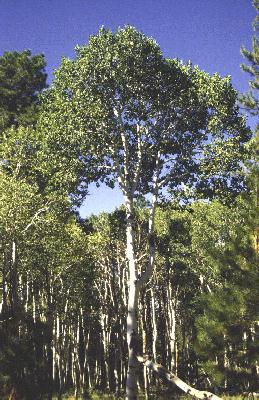Plant Data Sheet

Species (common name, Latin
name)
Quaking Aspen, Populus tremuloides
Range
Most widely distributed tree in
Climate, elevation
Colder inland climates over humid coastal climates; near sea
level to 3050m (Rose et al., 1998)
Local occurrence (where, how
common)
Widely used in landscaping for noise reduction and visual screening (Rook, 2002); along waterways, road cuts, and forest edges.
Habitat preferences
Well drained, high in calcium, loamy soils. Sites disturbed by fire and logging with exposed mineral soil. Grows along forest edges and waterways-shade intolerant (Rose et al., 1998)
Plant strategy type/successional stage (stress-tolerator,
competitor, weedy/colonizer, seral, late successional)
Occurs in pure stands as a succesional
species that is replaced by conifers (Rook, 2002)
Associated species
Acer rubrum, Abies balsamea,
Fraxinus nigra, Populus spp., Cornus spp., Rubus spp., Aster macrophyllum, Smilacina
stellata, Galium triflorum (Rook, 2002)
May be
collected as: (seed, layered, divisions, etc.)
Seed and vegetative root suckers (Rose et al., 1998)
Collection restrictions or
guidelines
Collect seed from May to mid-June. Collect cottony, wind-borne seeds about a week before capsule opens. Collect lateral roots when plant is dormant-ideally early spring (Rose et al., 1998)
Seed germination (needs
dormancy breaking?)
Place end of branch with female catkins in water of 8-10°C, high air temperature, and low relative humidity. Remove seeds from capsule once it opens. (Rose et al., 1998)
Recommended seed storage conditions
Dry seeds for three days at 24°C.
Viable for one year stored at 5°C and 5-8% moisture content (Rose et al., 1998)
Propagation recommendations
(plant seeds, vegetative parts, cuttings, etc.)
Optimal germination of seeds is at 15-25°C. Surface sow in very moist seedbed; keep well watered. Collect roots for vegetative reproduction that are 1-2cm in diameter and 2.5cm in length (Rose et al., 1998)
Soil or
medium requirements (inoculum necessary?)
Plant cuttings 1.3cm deep in vermiculite
for six weeks. Cut suckers and place in vermiculite:perlite
mixture and mist for 2-3 weeks. Transplant to peat:vermiculite
mixture for growth. Temperatures between 15-25°C (Rose et al., 1998)
Installation form (form,
potential for successful outcomes, cost)
Container, 12-48” (Fourth, 2003); 0.5-1 gallon (Watson,
2003)
Recommended planting density
Close proximity, within 25' (Rook, 2002)
Care requirements after
installed (water weekly, water once etc.)
Must be planted in soil with high moisture content or watered on a daily basis (Watson, 2003)
Normal rate of growth or
spread; lifespan
Rapid growth rate, 40ft. at 20 years of age, 65ft. at
maturity (VegSpec, 2003); 100+ years old for vigorous
individuals (Perala, 1990)
Sources cited
1) Fourth Corner Nurseries. www.4th-corner-nurseries.com;
2) Perala, D.A. Silvics of
3) Rook, Earl. Plants of the North.
http://www.rook.org/earl/bwca/nature/flora.html.
4) Rose, Robin, Caryn Chachulski, and Diane Haase. Propagation of Pacific Norhtwest Native
Plants.
5) VegSpec. Phil Smith, Project
Manager. http://ironwood.itc.nrcs.usda.gov/Netdynamics/Vegspec/pages/HomeVegspec.htm,
USDA, Natural Resource Conservation Service.
6) Watson, Rae. Forestry Technician. http://nativeplants.for.uidaho.edu/network/view.asp?protocol_id=2370. USDA, J. Herbert Stone Nursery. Protocol Information.
Data compiled by (student
name and date)
Scott Olmsted; 041403